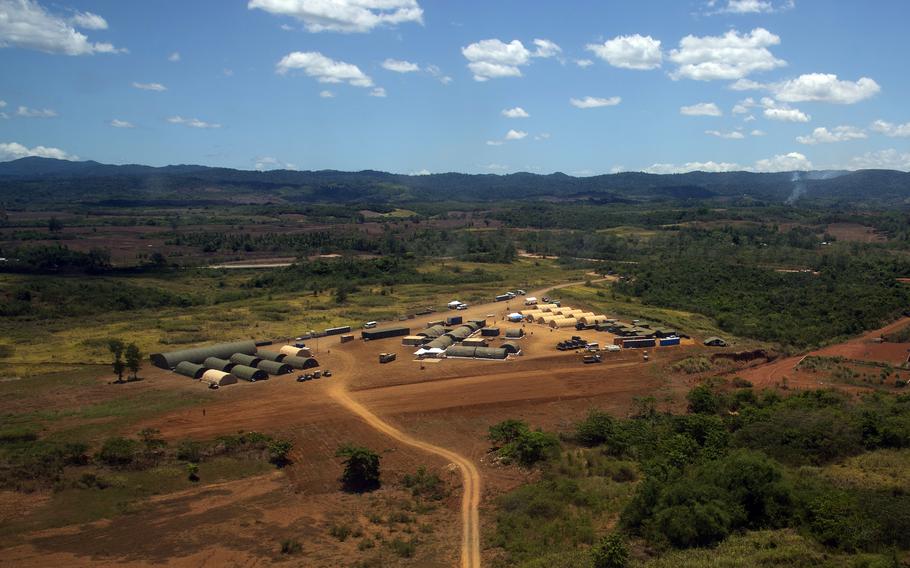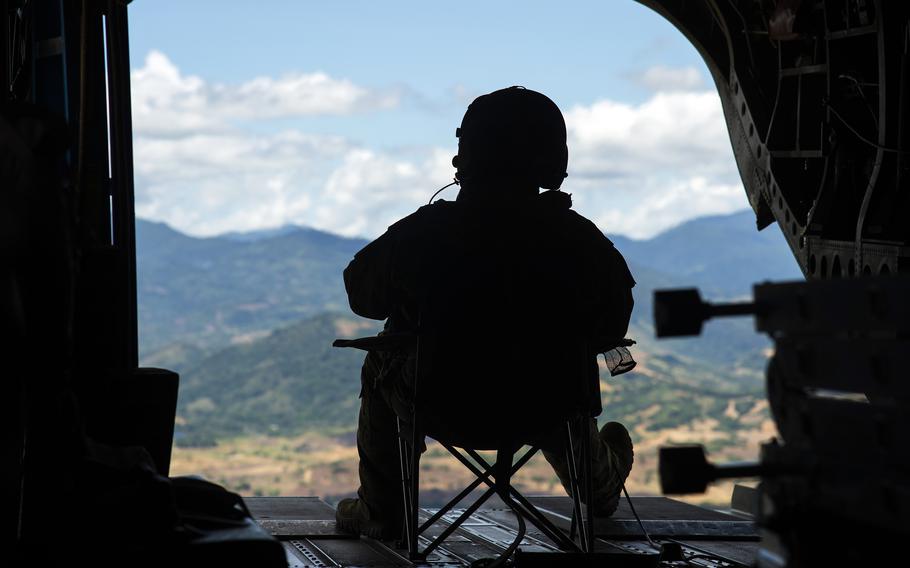
U.S. soldiers operate out of Logistics Support Area Mountain Medic, a clearing beside Lal-lo Airport the size of several football fields, during Balikatan training in the Philippines on May 4, 2024. (Jonathan Snyder/Stars and Stripes)
LAL-LO AIRPORT, Philippines — This dusty provincial airport near the Luzon Strait has seen few improvements since it was added to a list of sites where U.S. forces are authorized to operate in the Philippines.
Last year, Lal-lo — also known as Cagayan North International Airport — became one of nine facilities approved for use by U.S. troops under the Enhanced Defense Cooperation Agreement.
Little investment has gone into Lal-lo, which features a runway, small terminal, control tower and fire station, since its EDCA designation, but the United States is writing checks for millions at other sites.
In November, for example, the Philippine government reopened a 10,000-foot runway north of Manila at Cesar Basa Air Base, following a $24 million, U.S.-funded renovation.
The U.S. has paid $66 million for Basa projects, including a warehouse and fuel storage tanks, the Philippine Inquirer reported Nov. 8. The U.S. Defense Department has earmarked another $35 million this fiscal year to build a parking apron for transient aircraft there.
Lal-lo, however, hasn’t changed much since it was approved for American forces, Maj. Shane Hinton, operations officer for the 2nd Battalion, 25th Aviation Regiment, said at the airport Saturday.
American helicopters have flown from the facility for the past few years ,and the only change he has noticed this year is a little more ramp space, said Hinton, who is based at Wheeler Army Airfield, Hawaii.
The lack of hangars means soldiers have been maintaining helicopters outdoors in the tropical heat during Balikatan, an annual exercise that began April 22 and wraps up Friday.
Balikatan is Tagalog for “shoulder-to-shoulder,” and the Philippines is considered the oldest U.S. security ally in the Pacific.
More ramp space at Lal-lo and a hangar would improve the airport, which is closed to civilian traffic during the drills, Hinton said.
The force operating there for Balikatan — Task Force Diamondhead — includes five UH-60 Black Hawk helicopters from 2nd Battalion and three more Black Hawks and four CH-47 Chinooks from 3rd Battalion, he said.
The soldiers live beside the airport at Logistics Support Area Mountain Medic, a clearing the size of several football fields. It includes a tent hospital, dining facility, container gym and about 16 air-conditioned tents where soldiers sleep and shelter from the heat.
The soldiers at Lal-lo have made a terrain map of their operations area. It stretches from Fort Magsaysay, another EDCA site about 80 minutes by air to the south, to the Batanes, a group of islands that comprise the Philippines’ northernmost territory.
Batan, an island where U.S. and Filipino troops practiced air assaults this week, and the others in the group are just south of the 70-mile-wide Bashi Channel between the Philippines and Taiwan.
The waterway would be strategically important in the event of a conflict in and around Taiwan, which Chinese leader Xi Jinping has pledged to reunify with the mainland, by force if necessary.
The aviators at Lal-lo this year have been flying missions to Batan and two more islands in the Batanes group, Mavulis and Itbayat, Hinton said.
Mavulis is the most challenging to fly to because of the small landing area, said Spc. David Bell, a Black Hawk mechanic and crew chief.
Lal-lo’s field hospital, which offers a blood bank and surgery, is operated by 120 soldiers from the 10th Field Medical Hospital out of Fort Carson, Colo.

Army Staff Sgt. Nicholas Endres, a CH-47F Chinook flight engineer with 3rd Battalion, 25th Aviation Regiment, flies to Lal-lo Airport during Balikatan training in the Philippines on May 4, 2024. (Jonathan Snyder/Stars and Stripes)
Mountain Medic’s dining facility doesn’t include cooks. It’s just a tent full of pre-packaged “Jimmy Deans,” Meals Ready to Eat and bottled water.
The aviation units have 96 soldiers at the base and 60 more back at Fort Magsaysay, Hinton said.
The troops have some relief from the spartan conditions. A mile up the road there’s a restaurant and bar called the Reggae Ranch that serves pizza, tacos, hamburgers and cold drinks.
The soldiers are popular customers, Judy Segurado, the restaurant’s manager, said Saturday afternoon as helicopters buzzed over the eatery.
“It’s good for our business,” she said of the American presence, but added, “We also like Chinese, especially the investors.”
The commander of the aviators’ higher headquarters at the 25th Combat Aviation Brigade, Col. Matt Scher, who was visiting troops at the airport Saturday, said his brigade has been coming to the Philippines regularly since 2014. The missions there are part of the Army’s Pathways exercise series, which tests units’ ability to deploy forces across the region.
Lal-lo’s designation as an EDCA site may result in better facilities for the aviators and their valuable gear, he said.
The site is also hosting 70 refuelers and air traffic controllers from Marine Aircraft Group 24 at Marine Corps Air Facility Kaneohe Bay, Hawaii, Scher said.
“We are training in a strategically relevant environment,” he said, while declining to speak about how the drills related to the potential threat posed by China. “We are demonstrating combat credibility on the first island chain. It has a deterrent effect.”